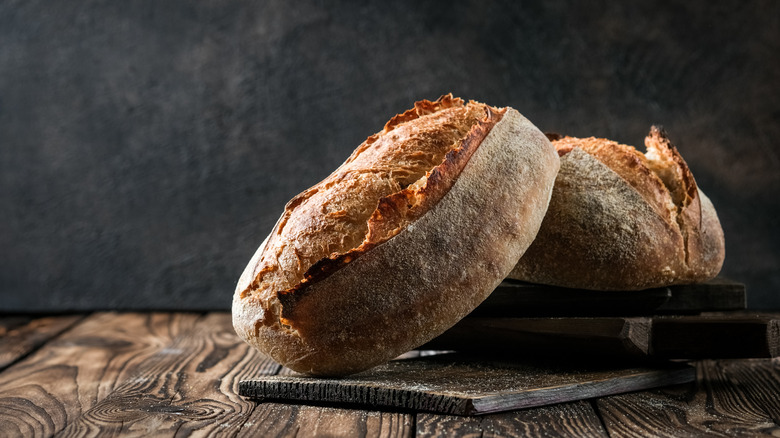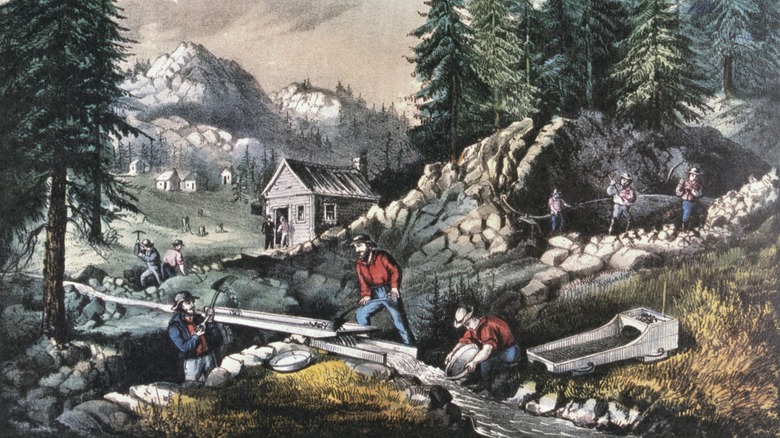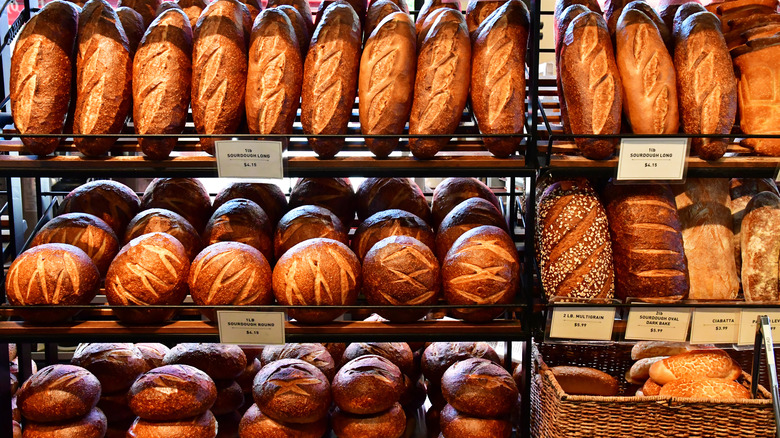The Unappetizing Origins Of San Francisco Sourdough
Making sourdough takes a lot of patience, but it's one of the most rewarding experiences you can have in the kitchen. It's more than baking; it's a way to tap into the past. When you make sourdough, you add another link in a culinary chain that stretches back at least as far as ancient Egypt.
Per NPR, sourdough is the oldest form of leavened bread, and the fundamental concept of trapping wild yeast in a sourdough starter has remained constant throughout the ages. However, the ways we utilize sourdough starters have evolved over time. As sourdough spread across the globe, it was adapted into various regional cuisines. But there's arguably no locale on Earth more closely tied to sourdough than San Francisco.
Fog City's famously gray skies are the ideal habitat for the wild yeast and bacteria that give sourdough its rise and flavor. Smithsonian recounts a long-standing local belief that such bread could only be made within a 50-mile radius of the city center. This is untrue, as sourdough can be made from a wide variety of natural yeasts and lactic acid bacteria. However, researchers discovered a particular type of bacteria in that foggy air that lends an extra-sour flavor. And while it's also been found in France and Germany, it still bears the scientific name L. sanfranciscensis. Sourdough has played a significant role in San Francisco's history — but in the early days, it was pretty unappetizing.
Sourdough was a Gold Rush staple
The discovery of gold near Sacramento in 1848 brought hundreds of thousands of people to Northern California, ultimately ushering it into statehood (per Britannica). San Francisco, being a principal point of entry, saw massive growth during this time. When the first prospectors arrived, few people in America were eating sourdough and would probably find it unappetizing.
Atlas Obscura cites a 19th-century cookbook stating that bread should have a "sweet, pleasant taste." Bakers achieved this by using commercial yeast or yeast derived from beer-making (known as "barm"). However, these ingredients were scarce and expensive on the frontier (and it's not like the miners could walk on down to the corner bakery from their remote encampments). They turned to sourdough, which provided a cheap foodstuff that, with minimal upkeep, could last indefinitely.
Sourdough became a staple of Gold Rush prospectors, so much so that miners were colloquially known as "sourdoughs." According to Smithsonian, miners would cuddle up with their sourdough starter on cold nights to prevent the yeast and bacteria from freezing. But unfortunately, these prospectors weren't skilled in the art of baking. Atlas Obscura explains that they often cooked bread over a fire using the same pan they used when panning for gold. This resulted in dense, poorly-risen loaves that had an overwhelmingly sour taste. Letters and diaries written on the frontier often spoke of foul-tasting loaves and stomachaches.
European immigrants changed sourdough for the better
The Gold Rush days gave sourdough a rather poor reputation. Atlas Obscura writes that sourdough was considered to be a mark of unskilled and unmarried men who, if they ever struck it rich in the mines, would do well to return to civilization and marry someone who knew a thing or two about baking. This sounds nothing like the sourdough we have today — so, how did it go from being a disgusting thing only fit for the rough and tough frontier to a trendy sensation in modern times? It turns out that, while the prospectors were busy turning out loaves that barely qualified as edible, another group of people was arriving in San Francisco, destined to change America's relationship with sourdough.
According to PBS, the California Gold Rush marked the largest population migration in United States history, bringing a wave of new people from around the world and transforming San Francisco from a small port town to a multicultural metropolis. Among the immigrants were French and Italian bakers who had experience with sourdough. (Better yet, they had real ovens.)
Per Atlas Obscura, these European bakers elevated sourdough from miners' food to a popular product. Take the example of Boudin Bakery, founded by French immigrants in 1849, which still survives as San Francisco's oldest continuously-operating business (per BBC Travel). More impressive still is the fact that it's been using the same sourdough starter the whole time.


